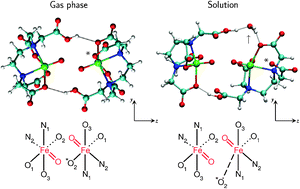An abiotic analogue of the diiron(iv)oxo “diamond core” of soluble methane monooxygenase generated by direct activation of O2 in aqueous Fe(ii)/EDTA solutions: thermodynamics and electronic structure
Abstract
We study the generation of a dinuclear

* Corresponding authors
a
STFC Rutherford Appleton Laboratory, Harwell Oxford, Didcot, UK
E-mail:
Leonardo.Bernasconi@stfc.ac.uk
b WCU program at Department of Chemistry, Pohang University of Science and Technology, Pohang 790-784, South Korea
c Department of Chemistry, University of Perugia, via Elce di Sotto 8, 06123 Perugia, Italy
d
Theoretical Chemistry Section, Vrije Universiteit Amsterdam, De Boelelaan 1083, 1081 HV Amsterdam, The Netherlands
E-mail:
E.J.Baerends@vu.nl
We study the generation of a dinuclear

 Please wait while we load your content...
Something went wrong. Try again?
Please wait while we load your content...
Something went wrong. Try again?
L. Bernasconi, P. Belanzoni and E. J. Baerends, Phys. Chem. Chem. Phys., 2011, 13, 15272 DOI: 10.1039/C1CP21244C
To request permission to reproduce material from this article, please go to the Copyright Clearance Center request page.
If you are an author contributing to an RSC publication, you do not need to request permission provided correct acknowledgement is given.
If you are the author of this article, you do not need to request permission to reproduce figures and diagrams provided correct acknowledgement is given. If you want to reproduce the whole article in a third-party publication (excluding your thesis/dissertation for which permission is not required) please go to the Copyright Clearance Center request page.
Read more about how to correctly acknowledge RSC content.
 Fetching data from CrossRef.
Fetching data from CrossRef.
This may take some time to load.
Loading related content
